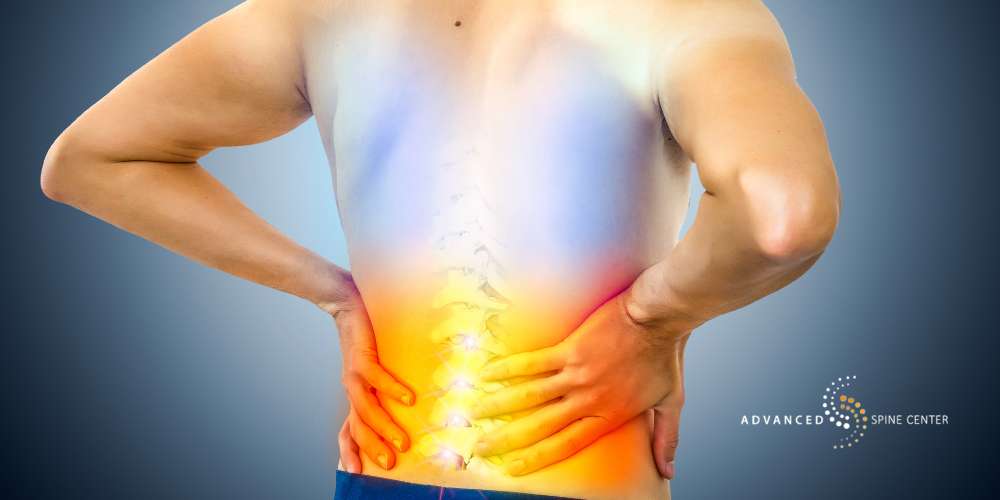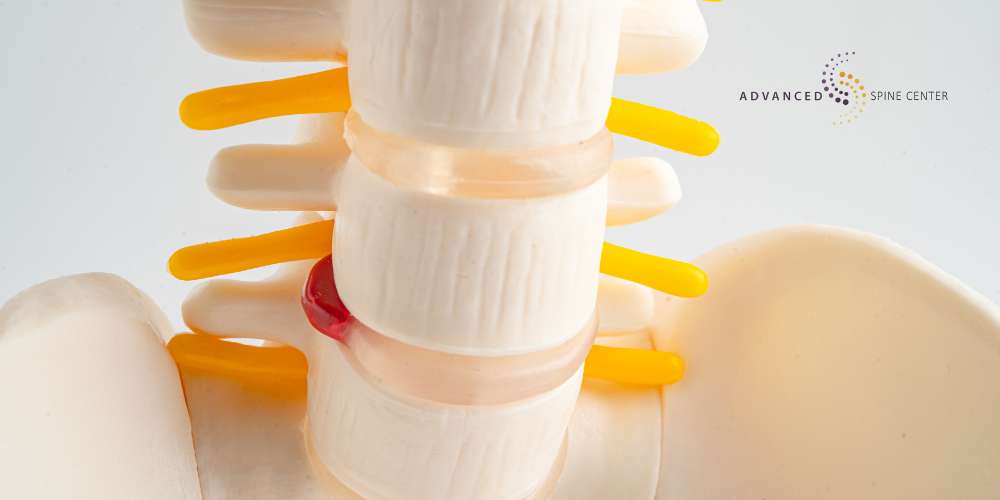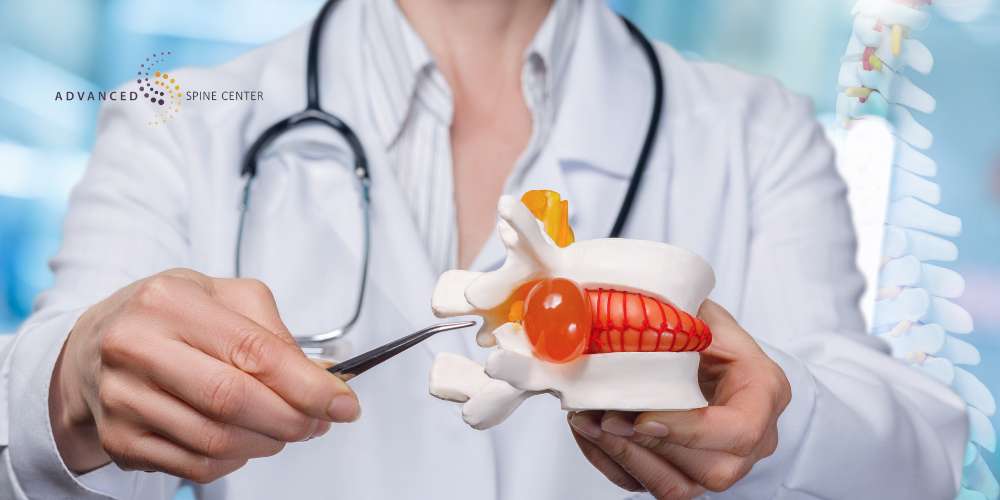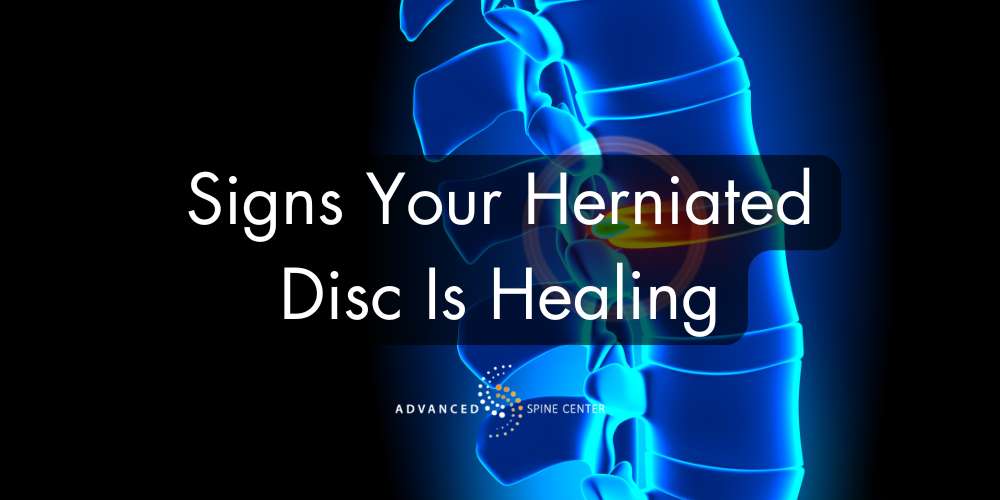If you suspect you have a herniated disc, it can be hard to tell whether or not your condition is improving. Luckily, there are a number of signs that could indicate that your herniated disc is healing, including changes in pain, improved sleep, and more. Below, we’ll take you through the stages of healing, as well as the common signs that may indicate that your ruptured disc is gradually healing itself.
If you’re experiencing symptoms of a herniated disc and are seeking relief, don’t hesitate to reach out for professional help. At the Advanced Spine Center in Plano, TX, you can receive specialized care from board-certified Plano orthopedic spine specialist Stephen P. Courtney, MD. He has experience treating a variety of spinal conditions, including herniated discs, and can provide you with a personalized care plan suited to your specific needs.
Take the first step towards healing and reclaiming your life—call us at (972) 499-5457 to schedule an appointment with our team.
What Is a Herniated Disc?
A herniated disc, also known as a slipped or ruptured disc, occurs when the soft inner material of a spinal disc protrudes through the tough outer layer. These discs rest between the vertebrae in the spine, protecting the bones from grinding against one another and providing space for the nerves in the back to stick out from the spinal column.
When a disk ruptures, the soft nucleus of the disc can press on the nerve roots in the spine, causing pain, tingling, and other symptoms. Disc herniation can be caused by injury, degenerative diseases like degenerative disc disease, and general wear and tear.
What Does a Slipped Disc Feel Like?
A slipped disc can feel different to different people, since the symptoms a person experiences often depend on the location of the disc and the severity of the herniation.
Common symptoms of a herniated spinal disc include:
- Sharp or shooting pain in the affected area
- Numbness or tingling sensations
- Muscle weakness
- Difficulty moving or bending
- Radiating arm or leg pain
- Stiffness in the affected area
- Increased pain with certain movements or activities
If you experience any of these symptoms, it could be a warning sign of a herniated disc in your neck or back.
Can a Herniated Disc Heal Itself?
Yes, many herniated discs heal on their own, especially with the help of physical therapy and over-the-counter pain medications. However, the amount of time needed for the disc to heal, as well as the effectiveness of the natural healing process, can vary greatly depending on various factors. Some of these factors include the severity of the herniation, the individual’s overall health, and the individual’s lifestyle choices.
How Long Does a Bulging Disc Take to Heal?
The healing time for a herniated disc can vary from person to person. In general, many people who engage in conservative treatments like physical therapy and medication therapy may see improvement in their symptoms within a few weeks to a few months.
However, some people may require more invasive treatments like surgery to aid in tissue repair and relieve them from their painful symptoms. An orthopedic specialist can provide you with a more accurate healing timeline based on your specific conditions and lifestyle.

Herniated Disc Recovery Time
After being diagnosed with a herniated disc, it’s important to understand the recovery process and how it may affect you and your daily life. Below is some helpful information on the healing process you may experience with your herniated disc.
Stages of Herniated Disc Healing
The herniated disc healing process occurs in stages, so it’s important to know what these stages are and what symptoms you may experience in each stage.
Stage 1: Inflammation
When the herniated disc begins healing, you’ll likely experience inflammation, which is the body’s natural response to the injury. This allows your body to begin the repair processes at the site of the injury. It may cause you to experience severe pain in and around the site of the herniation. Rest, ice, and anti-inflammatory medications can help alleviate symptoms and reduce inflammation during this stage of healing.
Stage 2: Progressive Improvement
As the inflammation begins to subside, you’ll likely experience improvement in your symptoms as well as increased mobility in your spine. During this stage, you may experience gradual relief from pain and may start to return to normal activities, but progress may vary depending on the severity of your herniation as well as other factors.
Physical therapy exercises and gentle stretching can help strengthen the surrounding muscles, improve flexibility, and promote better spinal alignment, further assisting the healing process.
Stage 3: Stabilization
In the stabilization stage, your body shifts focus from improving symptoms to maintaining the progress your disc has made over the previous stages. You should continue to adhere to your treatment plan, including any physical therapy, lifestyle modifications, and ergonomic adjustments, in order to ensure your herniated disc heals properly.
Stage 4: Long-Term Healing
In the final stage, your herniated disc will complete healing and provide you with spinal stability, as well as management of your symptoms. Most likely, you’ll experience decreased pain or complete relief from your disc pain. Adopting healthy lifestyle habits, including regular exercise, proper posture, and weight management, can support ongoing spine health and reduce the risk of future herniations.
Signs Herniated Disc Is Healing
As your herniated disc heals, you’ll likely notice a few changes in your condition, which may indicate that your herniated disc is healing. Below are some of the signs your herniated disc is healing.
Less Pain
One of the most noticeable signs that a herniated disc is healing is a reduction in pain. As inflammation decreases and the disc begins to heal, you’ll likely experience a decrease in the intensity and frequency of your pain.
Increased Mobility
Another positive indication of herniated disc healing is an increase in mobility and range of motion. As the surrounding muscles strengthen and inflammation subsides, you may find that you can move around more freely without experiencing as much stiffness or discomfort.
Fewer Muscle Spasms
For many patients, nerve irritation from a herniated disc can result in painful muscle spasms. As your disc begins to heal, you may notice a reduction in the frequency and intensity of these muscle spasms. This can lead to improved comfort and a greater ability to engage in physical activities without the interruption of painful muscle contractions.
Better Sleep
Improved sleep quality can be a positive sign that a herniated disc is healing. The pain and discomfort caused by a herniated disc can make it hard for individuals to find a comfortable sleeping position or may cause them to wake up in the middle of the night.
As the herniated disc heals, you may notice that you’re able to experience deeper, more restorative sleep, which can indicate that your condition is improving. Additionally, better sleep can improve your overall health and well-being, making it easier for your body to continue to heal.
Less Irritation of Nerves
Another sign that your herniated disc is healing is a decrease in irritation of the nerves surrounding the affected area. As the disc begins to heal and pressure on the nerves diminishes, you may notice less numbness, tingling, or weakness in your extremities. This is because your nerves are able to more easily transmit messages between the body and the brain, which indicates that your nerve function is improving.

What Is the Healing Process Like for Herniated Discs?
The healing process for a herniated disc differs from person to person, but many patients have similar experiences in the recovery process. Some of these changes are subtle, but they can indicate that the person’s disc is gradually healing. Below are some of these common experiences individuals have during the herniated disc healing process.
Less reliant on medication:
As the healing process progresses, individuals often find themselves relying less on things like pain medication and muscle relaxants to manage their herniated disc symptoms. This is often the result of increased mobility, decreased pain, and a decrease in muscle spasms.
Improved sensation:
Individuals also often experience improvements in their sense of feeling in certain areas. As pressure on the nerve roots decreases, those nerves can better send signals to the brain, allowing individuals to experience sensations in areas that were previously numb, tingly, or weak.
Improved sleep:
As their disc pain decreases, individuals often experience better sleep, which can lead to increased energy levels, better mood, and improved overall well-being.
Improved mobility:
Another part of the healing process for many people is an increase in mobility. As inflammation decreases and the surrounding muscles strengthen, individuals often find that they can move more freely, allowing them to return to their daily activities.
Changes in pain:
Throughout the healing process, some people notice changes in the nature and intensity of their herniated disc pain. While some may experience a gradual reduction in their pain, others may notice shifts in the location or nature of their discomfort.
Herniated Disc Surgery Recovery Time
The recovery time for herniated disc surgery can vary from patient to patient, depending on the nature of the surgery, the severity of the herniation, and individual health factors. In general, patients may return to normal daily activities within 2 to 4 weeks, but may have to wait 12 weeks or more before engaging in any strenuous activities.
An orthopedic surgeon can evaluate your condition, provide you with surgery options, and give you a more accurate recovery time estimate. Additionally, they may recommend you make certain lifestyle changes or ergonomic adjustments in order to ensure a speedy recovery.
How to Heal a Herniated Disc Quickly
In order to heal a herniated disc quickly, you should speak with an orthopedic professional who can provide you with a treatment plan that puts you on the fast track toward recovery. Oftentimes, this will include physical therapy exercises, lifestyle changes, and medication therapy.
Additionally, it’s recommended that you maintain a healthy weight, practice good posture, refrain from smoking, and adhere to all treatments in order to ensure you heal quickly and to reduce the risk of a future injury.
Herniated Disc Treatments in Plano
There are a variety of different treatments for herniated discs, including pain management strategies, minimally invasive surgeries, and lifestyle modifications. Some of the most common herniated disc treatments include:
- Rest
- Medications (such as NSAIDs, muscle relaxants, or corticosteroids)
- Physical therapy
- Epidural steroid injections
- Chiropractic care
- Acupuncture
- Massage therapy
- Heat and cold therapy
- Traction therapy
- Spinal decompression therapy
- Lifestyle modifications (such as weight management and proper ergonomics)
- Minimally invasive spine surgery (such as discectomy or microdiscectomy)
- Spinal fusion surgery
- Artificial disc replacement
If you are curious about a microdiscectomy surgery, or you have questions about disc herniation surgery, contact the orthopedic professionals at Advanced Spine Center. We provide a variety of treatment options for those with herniated discs and can develop a comprehensive treatment strategy designed for your personal needs.
Physical Therapy
Physical therapy plays a crucial role in managing herniated disc symptoms. A physical therapist can design a treatment plan that utilizes physical therapy exercises that strengthen the muscles surrounding the spine, improving flexibility, and promoting proper posture and body mechanics. These can help alleviate pressure on a slipped disc, which can promote healing, reduce inflammation, and enhance overall spinal stability.

Contact the Advanced Spine Center for Herniated Disc Treatment in Plano, TX
If you’re in Plano, Texas, and experiencing symptoms of a herniated disc, don’t wait to seek treatment. At the Advanced Spine Center, we offer comprehensive care for managing spinal conditions like herniated discs. With nearly 30 years of experience, Dr. Stephen Courtney is prepared to help provide you with the personalized treatment you need to heal.
Don’t let a herniated disc hold you back from enjoying life to the fullest. Contact the Advanced Spine Center today at (972) 499-5457 or contact us via our website to schedule an appointment with a member of our team.










